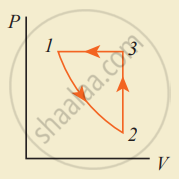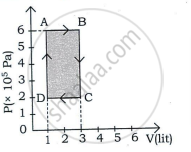Advertisements
Advertisements
प्रश्न
Explain the cyclic process.
Explain cyclic process with the help of neat and labelled p-V diagram.
उत्तर
- A thermodynamic process that returns a system to its initial state is a cyclic process.
- In this process, the initial and the final state is the same.
- For a cyclic process, the total change in the internal energy of a system is zero. (ΔU = 0).
- According to the first law of thermodynamics, we have, for a cyclic process, Q = W
- The given figure shows the p-V diagram of a cyclic process which is a closed-loop.

p-V diagram of cyclic process - Working of all heat engines is a cyclic process.
APPEARS IN
संबंधित प्रश्न
For work done to be reversible, the process should be ______
What is a thermodynamic process?
Draw a p-V diagram showing negative work with varying pressure.
Draw a p-V diagram showing positive work at constant pressure.
3 mole of a gas at temperature 400 K expands isothermally from an initial volume of 4 litres to a final volume of 8 litres. Find the work done by the gas. (R = 8.31 J mol-1 K-1)
Write a note on free expansion.
Explain the thermodynamics of the isobaric process.
Explain the thermodynamics of the isochoric process.
When a cycle tyre suddenly bursts, the air inside the tyre expands. This process is ____________.
When food is cooked in a vessel by keeping the lid closed, after some time the steam pushes the lid outward. By considering the steam as a thermodynamic system, then in the cooking process
The V-T diagram of an ideal gas which goes through a reversible cycle A→B→C→D is shown below. (Processes D→A and B→C are adiabatic)

The corresponding PV diagram for the process is (all figures are schematic)
Apply first law for an isothermal process.
Give the equation of state for an adiabatic process.
Draw the PV diagram for the isobaric process.
What is a cyclic process?
Can the given heat energy be completely converted to work in a cyclic process? If not, when can the heat can completely converted to work?
Explain the isobaric process and derive the work done in this process.
Consider the following cyclic process consist of isotherm, isochoric and isobar which is given in the figure.

Draw the same cyclic process qualitatively in the V-T diagram where T is taken along the x-direction and V is taken along the y-direction. Analyze the nature of heat exchange in each process.
For a given ideal gas 6 × 105 J heat energy is supplied and the volume of gas is increased from 4 m3 to 6 m3 at atmospheric pressure. Calculate
- the work done by the gas
- change in internal energy of the gas
- graph this process in PV and TV diagram
A thermodynamic system undergoes cyclic process ABCDA as shown in the figure. The work done by the system is ______

A monoatomic gas of pressure p having volume V expands isothermally to a volume 2V and then adiabatically to a volume 16V. The final pressure of the gas is ____________.
`("ratio of specific heats" = 5/3)`
One mole of an ideal gas with `gamma` = 1.4 is adiabatically compressed so that its temperature rises from 27° C to 47° C. The change in the internal energy of the gas is (R = 8.3 J/mol.K) ____________.
Two identical samples of a gas are allowed to expand (i) isothermally (ii) adiabatically. Work done is ____________.
In which of the following processes, beat is neither absorbed nor released by a system?
An ideal gas is taken through a cyclic process ABCDA as shown in figure. The net work done by the gas during the cycle is ______.

